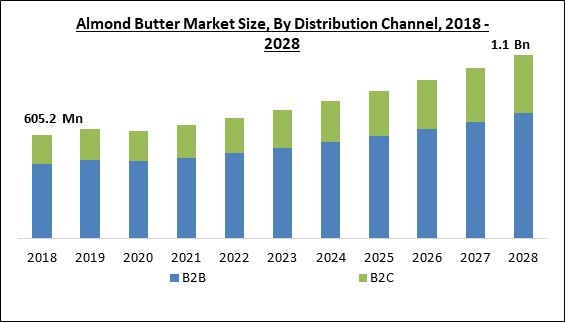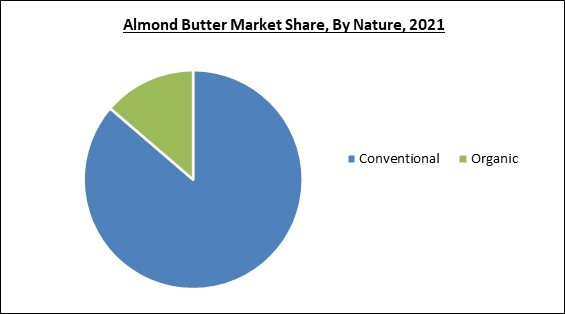The Global Almond Butter Market size is expected to reach $1.1 billion by 2028, rising at a market growth of 7.2% CAGR during the forecast period.
Almond butter is a plant-based butter obtained from raw or roasted almonds. Almond butter is crucial component in creating skincare goods like lotions, body creams, moisturizers, and others in the cosmetics business. A further factor encouraging manufacturers to include plant-based components like almond butter in their products is the growing public knowledge of the advantages of using cosmetics manufactured from plant-based ingredients.
In turn, this has fueled the expansion of the almond butter market. However, during the past few years, several nations have identified lifestyle-related disorders like obesity as a major concern, raising consumer awareness of health issues. As a result, recent years have seen a steady rise in health-conscious customers, particularly in developed economies.
Manufacturers of almond butter are constantly concentrating on introducing new goods to the market. For instance, producers are introducing organic almond butter to the market in addition to roasted almond butter, raw almond butter, flavored almond butter (such as almond butter with chia seeds and strawberry) and flavored almond butter with espresso and vanilla. This is anticipated to fuel the market's expansion throughout the projection period.
Because of their identification as a plant-based superfood, almonds are gaining immense popularity as a raw material for non-dairy goods. Almond protein powder and almond butter make non-dairy products with well-known nutritional advantages and great taste and texture. In addition, almond butter's popularity has grown due to its simplicity, with which it can replicate common dairy flavors.
The market research report covers the analysis of key stake holders of the market. Key companies profiled in the report include Hormel Foods Corporation, Hallstar, The Hain Celestial Group, Inc., Barney Butter, Nutty Novelties, 8th Avenue Food & Provisions, Cache Creek Foods, Nuts 'N More, Once Again Nut Butter and SOPHIM.
Almond butter is a plant-based butter obtained from raw or roasted almonds. Almond butter is crucial component in creating skincare goods like lotions, body creams, moisturizers, and others in the cosmetics business. A further factor encouraging manufacturers to include plant-based components like almond butter in their products is the growing public knowledge of the advantages of using cosmetics manufactured from plant-based ingredients.
In turn, this has fueled the expansion of the almond butter market. However, during the past few years, several nations have identified lifestyle-related disorders like obesity as a major concern, raising consumer awareness of health issues. As a result, recent years have seen a steady rise in health-conscious customers, particularly in developed economies.
Manufacturers of almond butter are constantly concentrating on introducing new goods to the market. For instance, producers are introducing organic almond butter to the market in addition to roasted almond butter, raw almond butter, flavored almond butter (such as almond butter with chia seeds and strawberry) and flavored almond butter with espresso and vanilla. This is anticipated to fuel the market's expansion throughout the projection period.
Because of their identification as a plant-based superfood, almonds are gaining immense popularity as a raw material for non-dairy goods. Almond protein powder and almond butter make non-dairy products with well-known nutritional advantages and great taste and texture. In addition, almond butter's popularity has grown due to its simplicity, with which it can replicate common dairy flavors.
COVID-19 Impact Analysis
The COVID-19 pandemic has fundamentally altered consumers' perceptions of the importance of consuming wholesome foods to boost immunity and disease resistance. Because items like almond butter provide the necessary amount of protein and nutrients, this factor will likely boost sales of those goods soon. The easing of the lockdown, travel bans, and trade restrictions resulted from the market conditions improving since the year 2021 began. There is anticipation that the market will soon show positive results because the supply chains of the almond butter market have begun to improve. In conclusion, it could be said the market has initially witnessed a slight decline in sales but has eventually profited from the pandemic outbreak in the long term.Market Growth Factors
Grown demand for plant-based products
Almond butter contains numerous additional elements that boost heart health and reduce the chance of developing cardiovascular disease. Omega-3 fatty acids aid in preventing irregular heartbeats. Plaque buildup in the arteries may be prevented by vitamin E. In addition, rising instances of dairy butter-based food intolerances and heightened awareness of animal welfare have led to the increasing popularity of veganism. In addition to veganism, the population of vegetarians is also a significant element driving the expansion of the almond butter market.Rising demand for almond butter-based cosmetics
Almond butter is an excellent source of vitamins, minerals, and monounsaturated fats. It contains large quantities of Vitamin E, which promotes healthy skin, scalp, and body. In addition, almond butter plays a significant function in tissue repair and regeneration due to its high protein content. Vitamin E, known to be a skin-lightening agent, has been added to almond butter. The butter's oil works on the pigmented cells by penetrating deeply into the skin. With consistent use, consumers may notice a change in the color of the skin surrounding their eyes.Market Restraining Factors
Fluctuating prices of raw material
Almond prices have been impacted by the fluctuating global demand for them, particularly in developing nations like China and India. Distributors and food producers are also being affected by the lack of almonds and the fluctuating price. Companies that produce food and beverage goods are impacted by shifting raw material costs in terms of profit growth. The market is expected to have a negative impact on market growth during the projected period as a result of this.Nature Outlook
Based on nature, the almond butter market is segmented into organic, and conventional. In 2021, the organic segment acquired a substantial revenue share in the almond butter market. This can be because of the rising popularity of vegan and gluten-free products and the rising prevalence of veganism, as a growing number of consumers switch from meat- and dairy-based products to organic, chemical-free, and cruelty-free alternatives.Distribution Channel Outlook
On the basis of distribution channel, the almond butter market is fragmented into B2B and B2C. The B2B segment held the highest revenue share in the almond butter market in 2021. The B2B segment’s growth is driven by the increasing use of almond butter in the food & beverage processing industry, like in dips, sauces, dressings, and soups, among other applications. In addition, the demand for almond butter-based cosmetics is also propelling the segment’s growth.Regional Outlook
Region wise, the almond butter market is analyzed across North America, Europe, Asia Pacific and LAMEA. The Asia Pacific region covered a considerable revenue share in the almond butter market in 2021. This is owing to the significant growth of the organic food business and the region's cosmetics and personal care market. Growth in the Asia-Pacific market is anticipated to be driven by India and China's increased usage of almonds spread and adoption in the pharmaceutical industry. In addition, rising investments in the food industry by several large firms is another element driving growth in the target market for this region.The market research report covers the analysis of key stake holders of the market. Key companies profiled in the report include Hormel Foods Corporation, Hallstar, The Hain Celestial Group, Inc., Barney Butter, Nutty Novelties, 8th Avenue Food & Provisions, Cache Creek Foods, Nuts 'N More, Once Again Nut Butter and SOPHIM.
Scope of the Study
By Distribution Channel
- B2B
- Food & Beverage Processing Industry
- HoReCa
- Personal Care & Cosmetic Industry
- B2C
- Hypermarkets & Supermarkets
- Convenience Stores
- Online
- Others
By Nature
- Conventional
- Organic
By Geography
- North America
- US
- Canada
- Mexico
- Rest of North America
- Europe
- Germany
- UK
- France
- Russia
- Spain
- Italy
- Rest of Europe
- Asia Pacific
- China
- Japan
- India
- South Korea
- Singapore
- Malaysia
- Rest of Asia Pacific
- LAMEA
- Brazil
- Argentina
- UAE
- Saudi Arabia
- South Africa
- Nigeria
- Rest of LAMEA
Key Market Players
List of Companies Profiled in the Report:
- Hormel Foods Corporation
- Hallstar
- The Hain Celestial Group, Inc.
- Barney Butter
- Nutty Novelties
- 8th Avenue Food & Provisions
- Cache Creek Foods
- Nuts 'N More
- Once Again Nut Butter
- SOPHIM
Unique Offerings
- Exhaustive coverage
- The highest number of Market tables and figures
- Subscription-based model available
- Guaranteed best price
- Assured post sales research support with 10% customization free
Table of Contents
Chapter 1. Market Scope & Methodology
Chapter 2. Market Overview
Chapter 3. Global Almond Butter Market by Distribution Channel
Chapter 4. Global Almond Butter Market by Nature
Chapter 5. Global Almond Butter Market by Region
Chapter 6. Company Profiles
Companies Mentioned
- Hormel Foods Corporation
- Hallstar
- The Hain Celestial Group, Inc.
- Barney Butter
- Nutty Novelties
- 8th Avenue Food & Provisions
- Cache Creek Foods
- Nuts 'N More
- Once Again Nut Butter
- SOPHIM
Methodology

LOADING...










